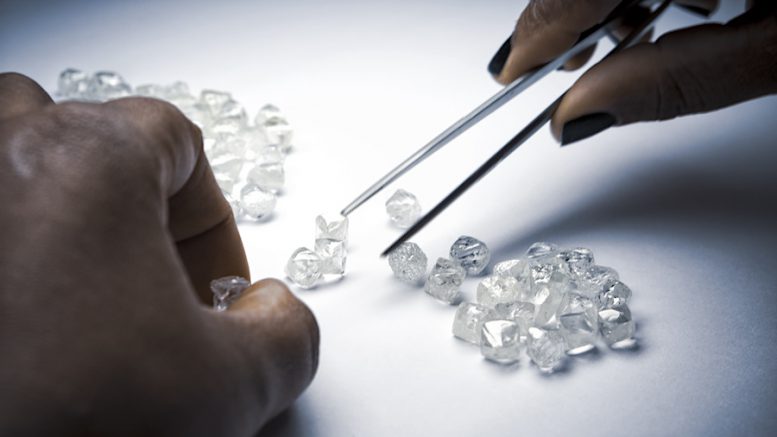It’s been a tough ride for the diamonds sector since rough prices hit an all-time high in the first quarter of 2022. Last year rough prices fell 15-20% according to the Zimnisky Global Rough Diamond Price Index. Prices are now down about 25% from their early 2022 high.
So what happened to cause prices to tumble?
The pandemic years brought generational volatility to diamond supply. In 2020, production dipped to the lowest levels since the 1990s. A recovery in 2021 through 2023 ensued. However, the new “normal” for output is still some 15-30 million carats below pre-2020 levels.
Global diamond production should hit 118 million carats this year, which compares to an estimated 110 million carats in 2020, but well short of the 136 million carats in 2019 and the 147 million carats in 2018.
Demand for diamonds has been equally volatile over the last four years, impacting both rough and polished prices.
Last year, the industry experienced a “bullwhip effect” of sorts as producers and traders rushed to replenish depleted stock following furious demand in 2021 and early 2022. The flood of new goods resulted in the buyers of rough diamonds (the midstream comprised of rough buyers, polishers and jewelry manufacturers) stringently curtailing new purchases as 2023 wound down.
As a result, in last year’s fourth quarter, De Beers’ sales fell some 70% year-over-year in value terms – equating to an estimated US$1 billion build in stock. Russia’s Alrosa suspended all sales outright in October and November, resulting in the accumulation of stock worth hundreds of millions of dollars.
While the majors’ healthier balance sheets give them more flexibility in such situations, the impact on smaller, independent producers has been more immediate and consequential.
In late October, Canada’s Stornoway Diamonds filed for bankruptcy for a second time. The first time was in 2019 and the Renard mine in Quebec was most recently run by creditors of the previously listed company, including Osisko Gold Royalties (TSX: OR) and Investissement Québec. Stornoway put Renard on indefinite care and maintenance following what it described as a “significant and sudden drop” in global diamond prices. The mine, which began production in late 2016, has produced upwards of 2 million carats annually.
In early November, South Africa’s Petra Diamonds (LSE: PDL) deferred as much as US$60 million in capital projects related to the extension of its two primary assets, the Cullinan and Finsch mines. The impact on supply will likely be felt in the back half of 2024 and into 2025.
Lab-made diamonds have also had an impact on the natural diamond sector. However, while they currently make up about 20% of global diamond jewelry demand, they have yet to gain wide acceptance outside of the United States. It should also be recognized that they have added incremental demand – i.e. some buyers of lab-grown diamonds would never have considered a natural diamond.
2024 wildcard
Going into 2024, it is likely that miners will release into the market at least some excess stock they hold on any sign of a demand recovery. However, by the second half of the year, the market’s medium and longer-term supply dynamic could become more noticeable.

Paul Zimnisky
An added “wildcard” will be the impact of wider Western sanctions on Russian diamonds, which come into full force this year. While the immediate impact of the embargo may not be as acute as some are projecting, the risk of further supply disruptions remains a possibility, especially in the medium term.
As of March, all 1-carat-plus polished Russian stones (including those cut and polished outside of Russia) will be targeted by the G-7 countries and the larger European Union. As of September, the threshold will be expanded to include all stones 0.5 carat and larger. That said, the half-carat cutoff still excludes the majority of Russian supply by volume and an estimated 30-40% by value as Russian production is disproportionately skewed towards smaller diamonds.
On a more micro supply note, commercial production at the newly inaugurated Luele mine (formerly referred to as Luaxe) in Angola will ramp up this year. A nearly completed first-phase processing plant will allow the mine to produce up to 4-5 million carats annually, making it an important source of new supply as aging mines around the world are depleted.
During a press conference in November, Angolan officials said that Luele production could be “gradually” expanded as additional plant phases are added – which could eventually triple output. Luele’s resource is estimated at over 600 million carats, which could support a 60-plus year mine life.
A moderate recovery in both rough and polished prices is likely this year. Price gains from seasonal restocking early in the year will probably be modest, as supply that was held back late last year is sold. However, by mid-year the midstream’s efforts to control supply could start to take effect. That could be further compounded by the global supply impact of the sanctions on Russian diamonds.
Any price rise would still need to be supported by demand – for example, via a “soft landing” in a global macro-economic sense, which financial markets are implying. Demand out of China, the diamond industry’s second largest end-consumer market remains another key variable as the nation grapples with a secular slowdown in its economy and what some consider an emerging property crisis.
Paul Zimnisky is a chartered financial analyst and independent diamond industry consultant based in New York (www.paulzimnisky.com). He can be reached at paul@paulzimnisky.com and followed on X @paulzimnisky.


Be the first to comment on "What to expect in 2024 after diamond sector’s price plunge"